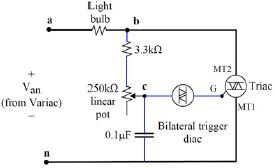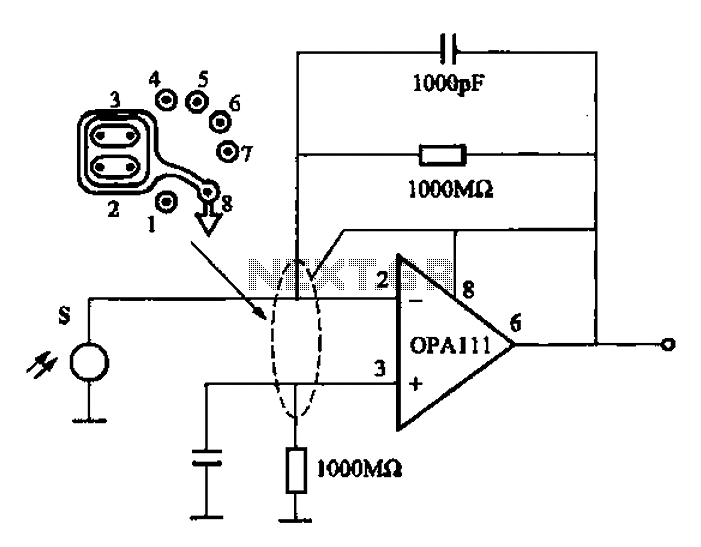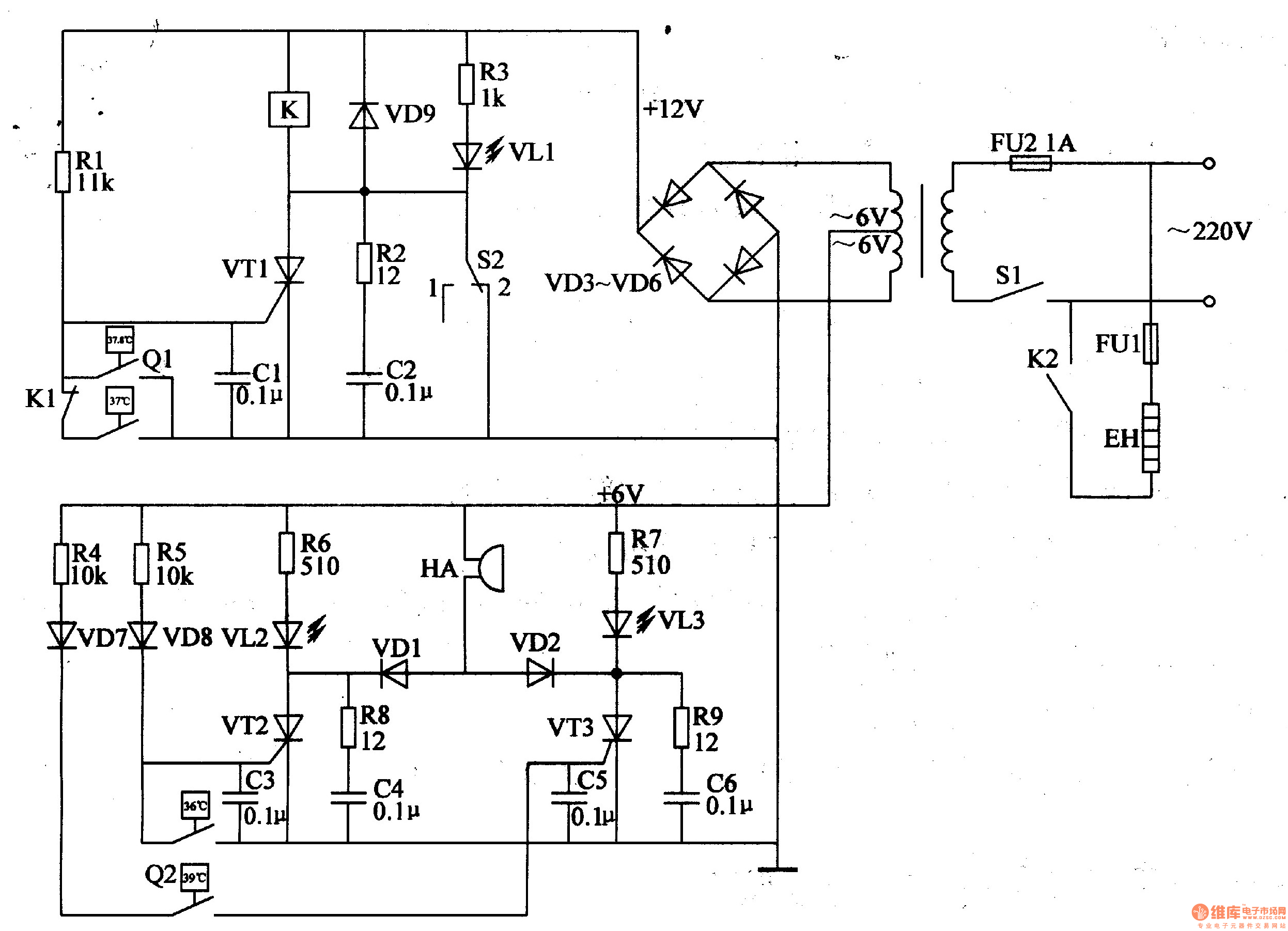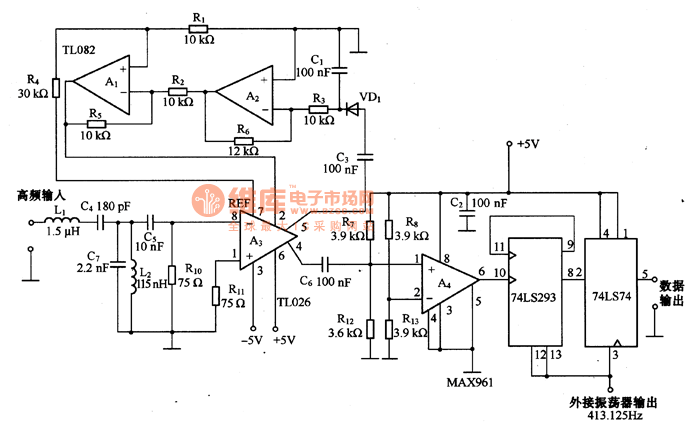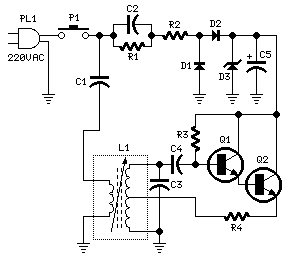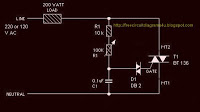
Simple Photoresistor Circuit
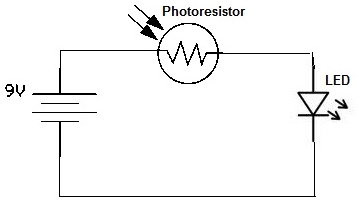
A simple photoresistor circuit will be constructed to demonstrate the operation of a photoresistor, which activates the circuit in the presence of light and deactivates it in darkness. This circuit connects a photoresistor to an LED. When the photoresistor is illuminated, the LED lights up and remains on. Conversely, when the photoresistor is in darkness, the LED turns off and does not illuminate. This project illustrates the functionality of a photoresistor. Under light exposure, the photoresistor exhibits low resistance, allowing current to flow through the circuit, thus powering the LED. The LED remains lit as long as the photoresistor is illuminated. In contrast, when the photoresistor is in darkness, it presents high resistance, preventing current flow and resulting in the LED being off. The LED remains unlit as long as the photoresistor is in darkness. This circuit configuration allows the LED to turn on in light and off in darkness. For a reverse operation—where the LED activates in darkness and deactivates in light—refer to instructions for building a dark-activated light circuit. The latter configuration is often more practical, as illumination is typically required in low-light conditions. This basic circuit serves as an educational tool, demonstrating fundamental principles of photoresistor functionality. However, for practical applications, utilizing a photoresistor to activate lighting in darkness is more advantageous.
The photoresistor circuit consists of a few essential components: a photoresistor (LDR), an LED, a resistor, and a power source. The photoresistor, which changes resistance based on light intensity, is the core element of this circuit. When light hits the photoresistor, its resistance decreases significantly, allowing a greater current to flow through the circuit. This current flows through the LED, causing it to emit light.
A resistor is typically included in series with the LED to limit the current flowing through it, preventing damage from excessive current. The value of this resistor can be calculated based on the LED's forward voltage and the desired current, using Ohm's Law (V = IR).
The power source can be a battery or a DC power supply, providing the necessary voltage for the circuit. The circuit can be assembled on a breadboard for prototyping purposes, allowing for easy adjustments and testing.
In applications where the circuit is intended to function inversely (LED on in darkness), a different configuration involving a transistor may be employed. In such a case, the photoresistor would control the base of the transistor, allowing it to switch the LED on when the light level drops below a certain threshold. This versatility of photoresistors makes them suitable for various light-sensitive applications, such as automatic night lights, street lighting, and other systems requiring light detection.
Overall, understanding the operation and configuration of a photoresistor circuit lays the foundation for more complex electronic designs that harness light sensitivity for practical uses.Now we will build a very simple photoresistor circuit to make a photoresistor do what it does: make the circuit work when there is light and stop working when there is darkness. For this circuit, we connect a photoresistor to an LED. When the photoresistor is exposed to light, the LED is on and stays lit. When the photoresistor is exposed to darkn ess, the LED turns off and does not light. This project demonstrates the function of a photoresistor. This is the photoresistor circuit when the photoresistor is exposed to light. When exposed to light, the photoresistor has very little resistance, so current can flow through the circuit. The LED receives current and lights up; it stays lit as long as the photoresistor is exposed to light.
This is the photoresistor circuit when the photoresistor is exposed to darkness. When exposed to darkness, the photoresistor has very high resistance, so current cannot flow through the circuit. The LED receives no current and, thus, does not light up. The LED stays off as long as the photoresistor is exposed to darkness. In this circuit, the LED turns on when the photoresistor is exposed to light and turns off when the photoresistor is exposed to darkness.
To learn how to build the circuit so that it`s the other way around- so that the LED turns on when the photoresistor is exposed to darkness and turns off when exposed to light, see How to Build a Dark-activated Light Circuit. This is a more practical and useful circuit, because we need light more when it`s dark rather than when it`s bright.
This basic circuit was illustrative in that it showed the basic principles of how a photoresistor worked. However, to use it for more advanced and useful circuits, using a photoresistor to turn on a light when it`s dark is more useful.
🔗 External reference
The photoresistor circuit consists of a few essential components: a photoresistor (LDR), an LED, a resistor, and a power source. The photoresistor, which changes resistance based on light intensity, is the core element of this circuit. When light hits the photoresistor, its resistance decreases significantly, allowing a greater current to flow through the circuit. This current flows through the LED, causing it to emit light.
A resistor is typically included in series with the LED to limit the current flowing through it, preventing damage from excessive current. The value of this resistor can be calculated based on the LED's forward voltage and the desired current, using Ohm's Law (V = IR).
The power source can be a battery or a DC power supply, providing the necessary voltage for the circuit. The circuit can be assembled on a breadboard for prototyping purposes, allowing for easy adjustments and testing.
In applications where the circuit is intended to function inversely (LED on in darkness), a different configuration involving a transistor may be employed. In such a case, the photoresistor would control the base of the transistor, allowing it to switch the LED on when the light level drops below a certain threshold. This versatility of photoresistors makes them suitable for various light-sensitive applications, such as automatic night lights, street lighting, and other systems requiring light detection.
Overall, understanding the operation and configuration of a photoresistor circuit lays the foundation for more complex electronic designs that harness light sensitivity for practical uses.Now we will build a very simple photoresistor circuit to make a photoresistor do what it does: make the circuit work when there is light and stop working when there is darkness. For this circuit, we connect a photoresistor to an LED. When the photoresistor is exposed to light, the LED is on and stays lit. When the photoresistor is exposed to darkn ess, the LED turns off and does not light. This project demonstrates the function of a photoresistor. This is the photoresistor circuit when the photoresistor is exposed to light. When exposed to light, the photoresistor has very little resistance, so current can flow through the circuit. The LED receives current and lights up; it stays lit as long as the photoresistor is exposed to light.
This is the photoresistor circuit when the photoresistor is exposed to darkness. When exposed to darkness, the photoresistor has very high resistance, so current cannot flow through the circuit. The LED receives no current and, thus, does not light up. The LED stays off as long as the photoresistor is exposed to darkness. In this circuit, the LED turns on when the photoresistor is exposed to light and turns off when the photoresistor is exposed to darkness.
To learn how to build the circuit so that it`s the other way around- so that the LED turns on when the photoresistor is exposed to darkness and turns off when exposed to light, see How to Build a Dark-activated Light Circuit. This is a more practical and useful circuit, because we need light more when it`s dark rather than when it`s bright.
This basic circuit was illustrative in that it showed the basic principles of how a photoresistor worked. However, to use it for more advanced and useful circuits, using a photoresistor to turn on a light when it`s dark is more useful.
🔗 External reference
